Łazienki Park
Łazienki Royal Park: Warsaw’s biggest park
One of the most beautiful palace and park complexes in Europe is Łazienki, which was established in the 17th century.
There are many wonderful architectural monuments in the landscaped garden. The most popular being the Palace on the Water by Jan Christian Kamsetzer and Domenico Merlini among others. It was built for Poland’s last monarch King Stanisław August Poniatowski and served as his summer residence.
The Palace-Garden complex houses a huge amazing park, which is a must see for any visitor in Warsaw. Here you’ll find 76 hectares of nature which basically in the center of the city as well as many other objects of history. This park was created within the old wild forest so the animals there are detained under their normal natural conditions.
Under the Fryderyk Chopin monument for over 50 years there have been free piano concerts on Sundays during the summer months for music lovers and the tourists to enjoy.
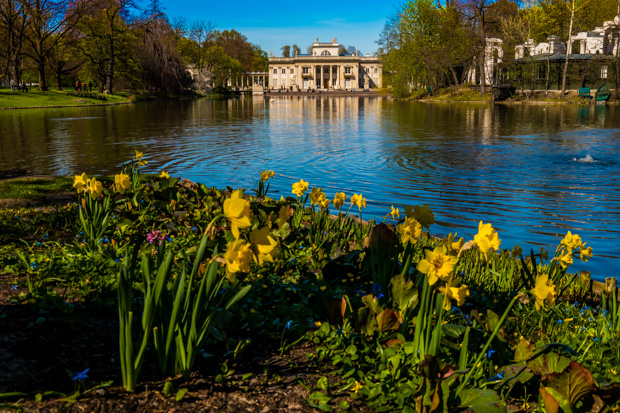 Palace on the Water
Palace on the Water
One symbol of Warsaw and an amazing piece of Polish architecture is the Pearl on the Island. This is the most important building in the garden area.
The last Polish king Stanisław August Poniatowski, is tied closely to this garden. He expanded a pavilion of Lubomirski’s Bath to be one of his residences. The palace survived WWII although it was heavily damaged and in 1960 it was opened again to the public.
Amphitheatre
On September 7th 1791, which was the anniversary of the election of King Stanisław August, the amphitheatre opened. It was based upon a design which was created by John Christian Kamsetzer. The building is situated on the pond bank and based upon older buildings which once stood there.
The Amphitheatre reminds one of the theatre in the Herculaneum. The area is topped with statues of famous writers. The stage reminds you of the ruins of the Roman Forum. The audience is separated from the stage by water which is its most unique feature.
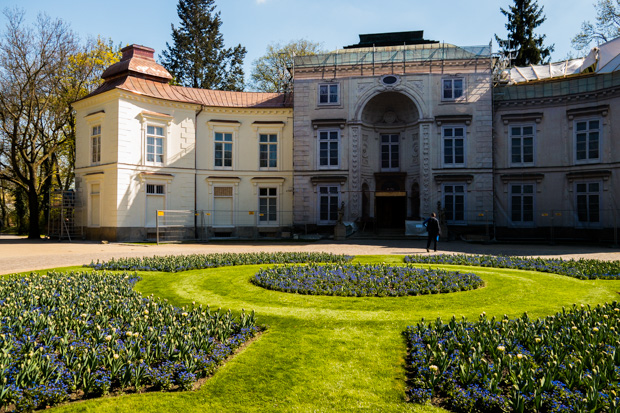 Myślewicki Palace
Myślewicki Palace
The palace gets its name from Myślewice village. This village was once located a short distance from the palace.
The walls of the palace were there in 1774, but no one knows the exact date of the entire construction. It was enlarged with two-story pavilions on the orders of King Stanisław August Poniatowski. This was combined with the main body. The structure was completed by Merlini. And it is maintained in the early classicist style which is just one of the few examples in Warsaw of this style that remain today. The original parts of the structure are the wings which feature a round outline. The shape of the roof was designed to resemble some patterns you find in the traditional style of Chinese art.
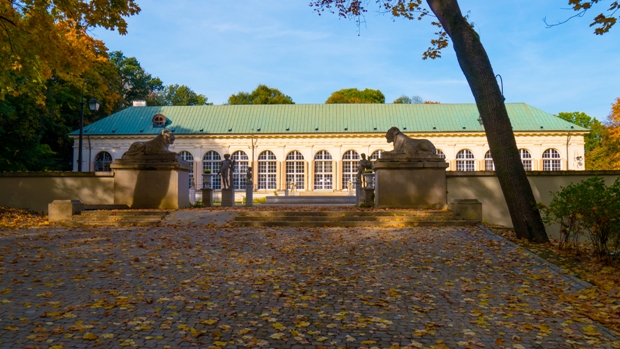 Old Orangery
Old Orangery
A wonderful interior can be found in the east wing. This features an authentic court theatre and is one of the only genuine examples of it in the entire world. The audience area is full of decorative. In the west wing there are guest rooms and living quarters for servants.
Podchorążówka
Next to the Palace on the Water, you’ll find this building.
It is located in the Eastern part of the garden. The Grand Office or Wielka Oficyna is there and it’s also called Military College or Podchorążówk. During Stanisław August’s reign the outhouse flats and kitchen were located here. The building became the Cadet School of Infantry in 1822 and its names today comes from this.
Pavilions of the Royal Lazienki Park
Barracks of the Cantonists
These barracks were built between 1826 and 1828 and were used as the Cavalry headquarters in the 17th century. They now house the Museum of Hunting and Horsemanship.
Egyptian Temple
The Egyptian Temple was constructed way back in 1822, but unfortunately, only a small portion of its original structure still remains in place. The temple is located near the pond. Its roof found great use as a bridge in days gone by, and the building was used as a glass glazed conservatory housing fig trees. Today, the temple is the site of the Museum of Scouting.
Hermitage
The Hermitage is a relatively small building which hosts a gallery where temporary exhibitions are held. It is also a venue for informal conferences and meetings with authors and artists. The building was first damaged in a fire during the rule of Stanlislaw August and was rebuilt in the 18th century by Dominik Merlini, which has persisted to this day.
Narutowicz House
The Narutowicz House was built in the 1930s and was meant to be a residential building for senior officers. It was also the residence of Gabriel Narutowicz, the first President of the Republic of Poland. Today, it is used as a nursery.
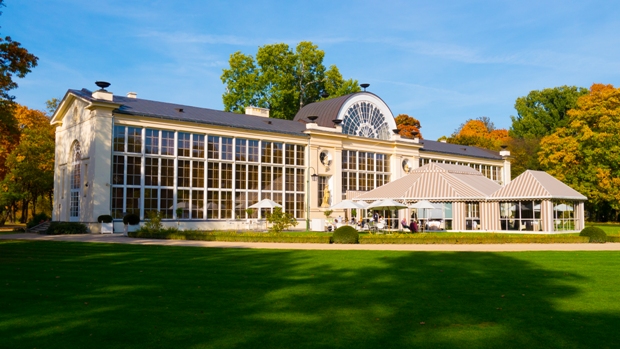 New Orangery
New Orangery
The New Orangery was designed by the architects Adam Adolphe Love and Józef Orłowski in 1860. In an earlier era, it was used to store the exotic plants of the palace during winters; today it is the site of a permanent garden and hosts a restaurant – the Belvedere.
Nowa Kordegarda
This building was built between 1779 and 1780 and served as an entertainment pavilion where a popular social game of that period, Trou Madam was played. It was converted into a manor theater room in 1782 and was called the Small Theater. Later, following the inauguration of the new Grand Theatre in the Orangery, the Small Theater was no longer in demand and the building was made into a storage space for sculptures.
Stara Kordegarda
This building was earlier meant to house the royal guards of the Palace in the Water and was built in the early 1790’s. These days it functions as the showroom of the Society of Fine Arts. Its design was inspired by J.Ch. Kamsetzer.
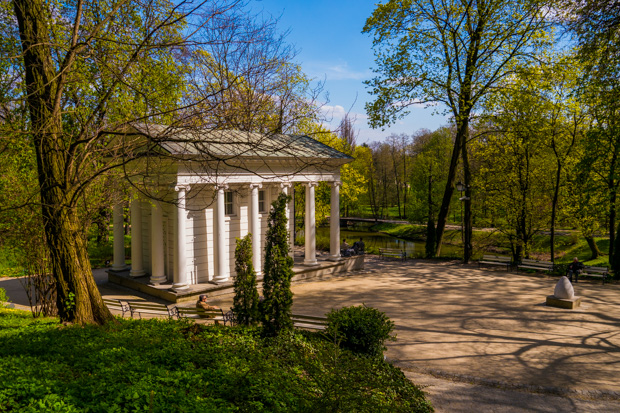 Temple of Diana
Temple of Diana
The Temple of Diana is an 1822 construction with architecture similar to the Greek buildings of an ancient era. Its interiors are decorated with glorious paintings and motifs, mainly of fruits and flowers.
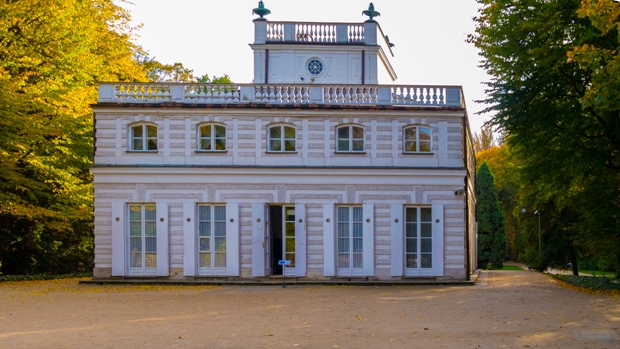 White Pavilion
White Pavilion
In 1774 the White Pavilion was built and it sits on the Royal Promenade. Dominik Merlini created this on command by Stanisław August Poniatowski. The painters Jan Ścisło and Jan Bogumił Plersch decorated the interior. This building is a memento to the King Stanisław period.
During WWII it wasn’t completely destroyed. The dining rooms feature original gigantic paintings. It has original Chinese wallpaper which is from the 18th century and is found in the drawing room. The paintings of Jan Bogumił Plersch are found in the office. The rooms are original and preserved. In the bedroom you’ll find the King’s authentic bed too.
Wodozbiór
At Wodozbior, the water flowing from the sources nearby was collected and then transferred to the park fountains as well as to the Bath. The building was rebuilt in 1827 in a style reminiscent of the tomb of Cecilia Matelli in Rome on the Via Appia. Today, the interior of the building is used as a gallery where exhibitions are held.
Impressive statues and monuments in Łazienki Royal Park
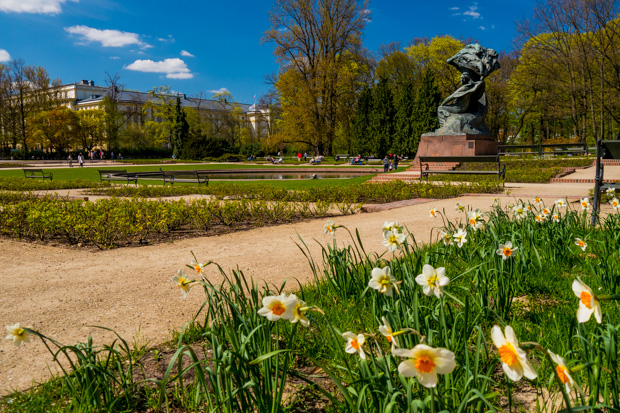 Chopin Monument
Chopin Monument
The Chopin Monument was a highly controversial one when it was first built because of how expressive it was. Today it is one of the most important structures in Warsaw, and is an integral part of the Royal Łazienki Park. The concerts held at its foot are a treat for tourists.
Henryk Sienkiewicz Monument
Here, you have the statue of one of Warsaw’s greatest writers, Henryk Sienkiewicz, who won great fame in Poland and abroad and was awarded the Nobel Prize for Literature in 1905.
Jan III Sobieski Monument
This monument was built to honor the leader of the Battle of Vienna, Jan III Sobieski for his glorious victory. It was built by Poland’s final king Stanisław August Poniatowski. The statue signified the values that were cherished by the king. However his rule was not a happy one and caused great damage to Poland’s standing in Europe. The monument was quite expensive to construct as well, which inspired great satire, such as this poem: “One hundred thousand for a statue. I would give double the money to freeze Stanisław and to wake up Jan.”





